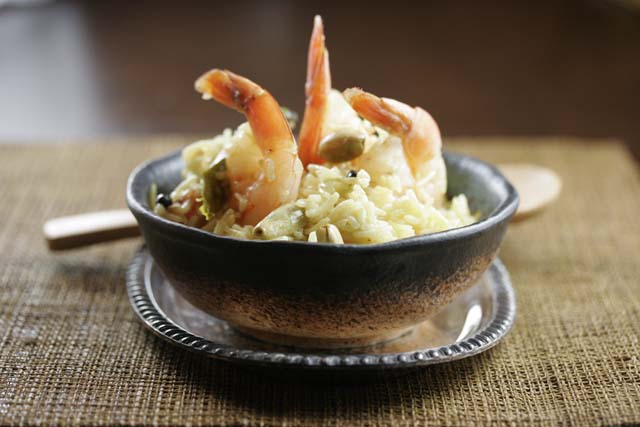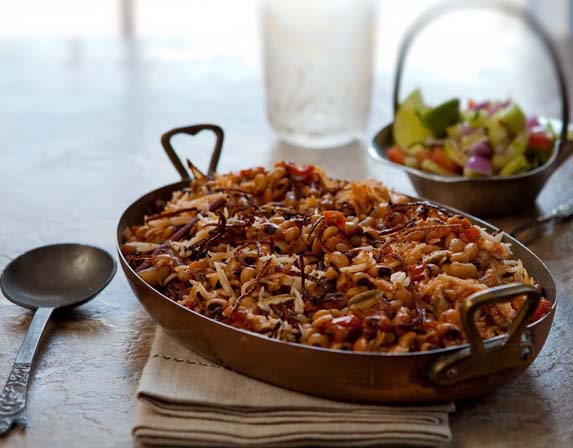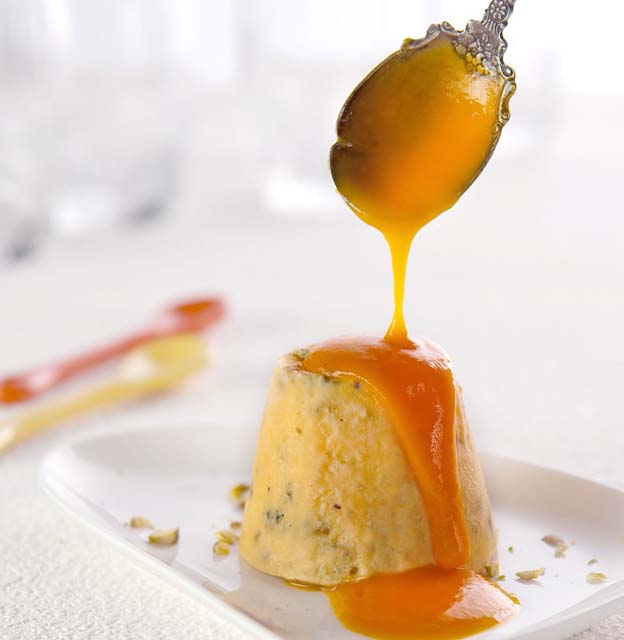Three Treats from Hari Nayak’s ‘My Indian Kitchen’

Chef Hari Nayak, author of ‘My Indian Kitchen’ shares three delicacies from his book – two of them can be complete meals in themselves – one for the non-vegetarians – Goan Shrimp Biryani (Coconut Shrimp Biryani) The other is a rice dish much beloved by vegetarians – Black Eyed Peas and Rice or Lobiya Pullao. And what better ending to a meal than to top this satisfying meal with Pista Aam Kulfi (Pistachio Mango Ice Cream)? Delicious in either language!

Coconut Shrimp Biriyani
Goan Jhinga Biryani
Biriyanis are flavorful one-pot meals loved by all Indians. Created by layering rice and meat or vegetables, they are usually elaborate dishes full of enticing flavors, and a huge part of Indian festivities such as weddings and religious occasions, especially in Muslim communities. Since they are complete meals, they are considered a great traveling food, and are typically served for dinner on trains. Though seafood or fish is not typically used to make biriyanis, here I was inspired to create my own biriyani using shrimp—a sort of Indian paella. If you have the patience to peel shrimp, buy them with the shell on. The shells can be used to make a stock for cooking the rice, creating a richer flavor. I find this delicious and hearty rice dish satisfying eaten on its own or with either a simple green salad on the side or with raitas such as Cucumber and Yogurt Raita or Avocado and Roasted Cumin Raita
Prep time: 10 minutes plus 40 minutes for soaking rice
Cook time: 15 minutes
Serves 6
1 lb (500 g) fresh, medium-size shrimp (30 to 35), preferably with shells on, peeled, deveined and cleaned (reserve shells)
2 cups (420 g) basmati rice
2 tablespoons oil
Two 1-in (2.5-cm) cinnamon sticks
4 green cardamom pods
½ teaspoon black peppercorns
1 large onion (about ½ lb/250 g), thinly sliced
1 tablespoon peeled and minced fresh ginger
1 tablespoon minced garlic
2 small fresh green chili peppers, chopped
¼ teaspoon ground turmeric
2 teaspoons salt
1 small tomato (about 3 oz/85 g), chopped
½ cup (125 ml) coconut milk, warmed
4 tablespoons chopped fresh coriander (cilantro), for garnish
1. If using shrimp with the shells on, place the shrimp shells and 2 cups (500 ml) of cold water in small pot. Bring the water to a boil and then reduce the heat to medium-low. Let simmer for about 40 minutes. Strain the stock and set aside.
2. Soak the rice for 30 to 40 minutes. Carefully pour out the soaking water and wash the rice in several changes of water, until the water runs clear. Leave it to drain in a fine-meshed strainer for about 15 minutes.
3. In a large nonstick saucepan heat the oil over medium-high heat. Add the cinnamon, cardamom pods and black peppercorns, and sauté until fragrant, about 1 minute. Add the onion and cook, stirring constantly, until golden, about 5 minutes. Mix in the ginger, garlic, green chili peppers, turmeric and 1 teaspoon of the salt, and cook, stirring constantly, until the ginger and garlic is cooked, about 1 minute. Add the chopped tomato and cook for another minute.
4. Add the shrimp and the remaining 1 teaspoon of salt and stir-fry over medium-high heat for about 1 minute, until the shrimp change color. If using shrimp stock, reheat the stock.
5. Add the drained rice and sauté for 1 minute. Add 1 cup (250 ml) of the hot stock or hot water and warmed coconut milk and bring to a boil over high heat. Reduce the heat to low and simmer, covered, until all of the water has been absorbed and the rice is done, 10 to 15 minutes. Top it with fresh coriander leaves and serve hot.

Black-Eyed Peas Rice
Lobhiya Pulao
This delicious rice dish is a very nutritious combination of protein and carbohydrates, making it a complete meal if served with a fresh green salad and any raita. This rice also makes a good partner for Madras Chicken or a vegetable dish, such as Cauliflower with Ginger and Cumin
Prep time: 20 minutes plus 5 hours for soaking beans and 40 minutes for rice
Cook time: 40 minutes
Serves 4
1 cup (150 g) black-eyed peas (lobhiya)
1¼ cups (260 g) basmati rice
3 tablespoons oil
2 onions (about ¾ lb/350 g), thinly sliced
4 garlic cloves, crushed
One 1-in (2.5 cm) piece fresh ginger, peeled and crushed
½ teaspoon ground turmeric
1 teaspoon ground cumin
1 teaspoon ground coriander
1 teaspoon Asian chili powder or cayenne pepper
1 tomato (about 1/3 lb/150 g), chopped
1 teaspoon
4 cups (1 liter) water
1 tablespoon ghee (clarified butter) or oil
2 green cardamom pods
4 whole cloves
One 1-in (2.5-cm) cinnamon stick
1 teaspoon Home-Style Garam Masala
1. Soak the beans in cold water for at least 5 hours or overnight.
2. Soak the rice for 30 to 40 minutes. Carefully pour out the soaking water and wash the rice in several changes of water, until the water runs clear. Leave it to drain in a fine-meshed strainer for about 15 minutes.
3. Heat the oil in a heavy-bottomed pan over medium heat. When hot, add the sliced onions and fry until brown and crisp, stirring frequently. Remove them with a slotted spoon, leaving as much of the oil in the pan as possible, and spread them out on a paper towel to drain. Set aside for garnish.
4. To the same pan that you fried the onions, add the garlic and ginger and sauté for 30 seconds over medium heat. Add the turmeric, cumin, coriander, Asian chili powder or cayenne pepper and tomato and cook until the oil separates from the masala, about 1 minute. Add the drained beans, salt, and water and cook, covered, until the beans are tender, about 30 to 40 minutes. Set aside. Do not drain the water.
5. In a heavy-bottomed pan, heat the ghee or oil over medium heat. Add the cardamom, cloves, and cinnamon stick and cook for a few seconds. Add the drained rice and sauté for about 1 minute, stirring gently so as not to break the rice grains.
6. Add the beans and their cooking liquid and bring to a boil. Add the Home-Style Garam Masala and reduce the heat to low. Cook, covered, until the water is evaporated and the rice is cooked, about 5 minutes. Stir once and garnish with the fried onions.

Pistachio Mango Ice Cream
Pista Aaam Ki Kulfi
Kulfi, literally “Indian ice cream,” can be made with any flavor of your choice, and is easier to make than American ice cream. In India, street vendors sell kulfi on a stick—like a Popsicle. Since good fresh mangoes are not available year-round, I recommend using the canned Alfonzo mango purée available in Indian grocery stores. The purée is refreshingly and tasty. Some purees are sweetened, so adjust the sugar according to your taste. I prefer to use rice flour as a thickening agent in this recipe because the resulting texture is creamier as compared to when cornstarch is used.
Prep time: 10 minutes plus 8 hours for cooling
Cook time: 30 minutes
Serves 8
1 cup (250 ml) heavy cream
6 cups (1.5 liters) whole milk
1 tablespoon white rice flour or corn starch
5 tablespoons sugar
½ teaspoon ground cardamom, preferably freshly ground green cardamom seeds (from about 6 green cardamom pods)
1 cup (250 ml) unsweetened, canned mango pulp or purée (or puréed flesh of 2 ripe, preferably Alfonzo, mangos)
½ cup (55 g) pistachios, chopped
1. In a heavy-bottomed saucepan, combine cream, milk and rice flour with a whisk until smooth. Bring it to a slow boil on medium low heat, stirring continuously to avoid scorching the milk. (Scorched milk adds an unpleasant taste and unattractive color to kulfi.) Once the milk has come to a boil, reduce the heat to low. Continue to cook for 30 to 40 minutes, until the mixture thickens. Stir regularly, scraping the sides of the pot and not the bottom to avoid mixing any scorched bits into the milk.
2. Turn off the heat. Stir in the sugar and cardamom. The consistency should resemble that of whipped cream. Set aside and cool for 20 minutes. Stir in the mango pulp and pistachios.
3. Evenly pour the mixture into eight 4 to 6-ounce (250 to 350-ml) individual serving containers or ramekins. Cover each of them tightly with plastic wrap and freeze for at least 8 hours or overnight. Remove the kulfi from the freezer about 5 minutes before serving. If you are serving the kulfi out of the molds, place each one under warm running water for 15 to 20 seconds. Hold the containers from underneath so that if the kulfi starts slip you can catch it. You might need to give the mould a firm tap on the top or sides if to release a stubborn one. Transfer the kulfi to individual dessert plates and serve.

3 Comments
Overseas Goans mostly eat fusion food. Traditional Goan food is often reserved for holidays like Christmas, when your extended family – like western born children and grandchildren who have an acquired taste, but cannot cook, come visit you. Biryani is very popular, more so than fish curries. Shrimp is favored over lamb.
Since South Asians are prone to cardiovascular diseases, our chefs have to get with it and not use 2 cups of rice for 500 grams of shrimp. Way too much rice! As a meal portion is one cup cooked MAX. For non-diabetics or the sedentary, one cup of uncooked Basmati rice and 750 gms of shelled shrimp is more like it. Use the shells to make a broth to add to the water that cooks the rice. (total 1.5 cups)
Time to try it!
I’ve heard of mutton and chicken biryani but never Goan shrimp biryani.